What kind of touch screens do modern smartphones have?
The touch display, as an information input/output device, appeared relatively long ago. Back in the 90s of the last century, PDAs and other portable devices equipped with a touchscreen could be found on sale. As technology has advanced, touchscreen smartphones have improved and new demands have been placed on them, so touchscreens have changed dramatically over the past decade.
Resistive sensors
The simplest and most affordable sensors for smartphones. They consist of two layers, on which a mesh of transparent conductive material is applied. The bottom one is made of glass (mineral or organic), and the top one is made of plastic. Between them there is a thin air layer. At the moment of touch, a circuit is closed between the grids of different layers, and the controller determines the coordinates of the location where the touch is made.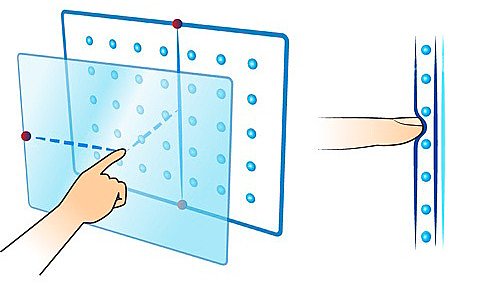
The advantages of resistive screens are sensitivity to pressure by any object, low cost, simplicity of design and accuracy. The main disadvantage is fragility: the plastic top layer is easy to cut or puncture, after which the contact will be broken and the sensor will not work.
Resistive sensors also have relatively low transparency (up to 80%), therefore, starting from 2010, they fall out of use on smartphones. Today, such a touchscreen can only be found in cheap Chinese-made phones.
Capacitive sensors
![]()
Capacitive sensors in smartphones consist of a glass panel covered with a transparent conductive layer and four corner sensors. A weak one is fed to her alternating current, the leakage of which, when touched, is recorded by sensors, calculating the coordinates of the press. In addition to the fact that such touchscreens only respond to touching an electrically conductive object, they have low accuracy and are not able to simultaneously perceive several taps.
Capacitive projection sensors
The most common type of sensor on modern smartphones. They represent a development of the previous type. Instead of a conductive layer, a grid of electrodes is applied to the panel, which are also energized. The moment you touch the finger, acting as a capacitor, a current leak occurs, the location of which is calculated by the controller. This design makes it possible to track multiple touches (on this moment up to 10, more - does not make sense) at the same time.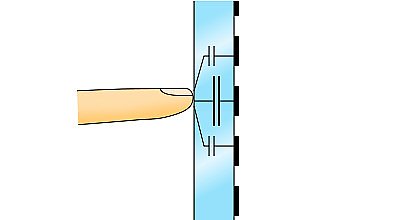
The basic design of such touchscreens by manufacturers mobile devices modified. On modern OGS smartphone displays, sensitive electrodes can be mounted directly between the crystals (or diodes) of the matrix, and the screen is covered with tempered glass to resist damage.
Previously, separation was also practiced protective glass and a sensor layer: electrodes were applied to a transparent film, which was covered with glass on top. This approach made it possible to maintain the functionality of the sensor even in the presence of serious damage (cracks, chips).
Touch phones are no longer new to anyone. Nowadays it is much more difficult to meet a person using a regular mobile phone. Increasingly, advanced users prefer models with a touch screen, because such phones are more mobile to control and are often equipped with the latest features, more high-tech.
To choose good phone With a touch screen, you need to approach it carefully, carefully studying all the functions and options offered.
Basic criteria for choosing a good touch phone:

In addition to screen sizes, the use of which is individual for each user, screens also vary in type. There are resistive screens, typical for budget mobile phones, which can be controlled not only with your fingers, but also with a stylus. And projection displays that can only be controlled with your fingers.
The advantages of second screens are that they are resistant to dirt, more sensitive, often equipped with a multi-touch function, more durable and transparent. Head-up displays are found mainly in expensive models.
If you do not want to use only the screen for control, purchase models with additional buttons or a retractable panel.
Accumulator battery
When choosing a good touch phone, it is important to pay attention to the battery. In budget models it is usually weaker, which does not allow long-term use phone in offline mode.
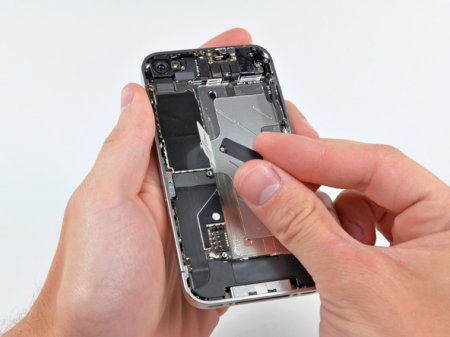
When choosing a good phone, be sure to pay attention to RAM. In modern middle-class models, its volume is on average 4 GB, this should be enough for comfortable use various applications and multimedia.
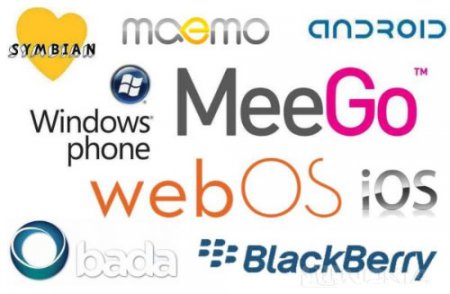
The most common systems are Android and IOS. The latter is typical for Apple products; its ease of use justifies the money spent. operating room Android system equipped with most mobile devices on the market. Therefore, if you choose touchscreen phone with the Android operating system, pay attention to its version, as well as to the site where you can download games for Android for free. Expensive models usually use newer versions of Android, while budget ones often include outdated ones.

When choosing a good phone, be sure to pay attention to the availability of communication functions: Wi-Fi, Bluetooth and others.
The criteria for choosing a good phone are individual for everyone, depending on the tasks that it will need to perform. There are models with support for 2 SIM cards or with an excellent camera that allows you to take high-quality pictures. When starting your selection, determine what you expect from a phone and take the time to compare a number of models, highlighting their advantages and disadvantages.
How to choose a good touch phone: video
Telephones are occupying an increasingly important place in every person's life. It all starts with trivial things like an alarm clock, business correspondence or a means of communication and ends with a pocket gateway to the Internet and an entertainment factory.
Nothing can be done with progress; users can only adapt to it by purchasing suitable models. True, there are difficulties with acquisition as such. They are easy to explain - the price is smart devices, including smartphones, is quite high.
And given the price in dollars and the exchange rate of the latter, not everyone can afford to buy a flagship device from a well-known company. Therefore, here there will be discussions on the topic of how inexpensive, but good.
Difficulty of choice
First of all, you need to decide not on the model or even the company that produces mobile devices, but on the operating system. It is on this issue that many discussions arise, they say, which ones are better and why choose at all.
Such questions should not be touched upon, at least not in this article. It is only necessary to state the fact that today the three most common mobile platforms- iOS, Android, Windows Phone.

And this is exactly the choice you have to make. Only then will questions begin, such as which phones are good and inexpensive touch phones, etc. For now, decide on the operating system.
Let's say you chose "Android" as the most balanced option in terms of many characteristics. This is reasonable, since there are many companies producing such products, which means there will be plenty to choose from. This is already a definite plus.
Selecting a manufacturer
The problem is how to choose a good one inexpensive phone, is that manufacturers, in order to reduce the cost of production, refuse some things that users need. In return, they leave something that they can do without.
Many companies make phones for this purpose. You can find enough good options and from manufacturers such as HTC, Sony, Nexus, Samsung and dozens of other global companies.
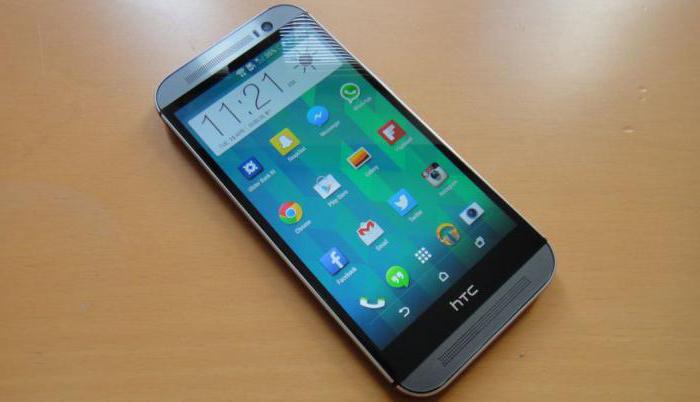
They differ mainly in design. Hardware, if we talk about such a topic as good inexpensive Android phones, is not a determining factor at all. In fact, it will not be the best - hence the low price. Therefore, you need to focus on something else. More on this below.
Underwater rocks
One of the biggest downsides of good inexpensive phones running this OS is the lack of updates. The fact is that today the next version of Android, Marshmallow, is being developed. Meanwhile, Lollipop was launched into production long ago. You don't understand what we're talking about yet, but wait a second.
Despite this, good inexpensive phones are equipped with KitKat at best, and this is the last generation. In most cases, these are even older versions, like 4.0 and 4.1. Of course, there is nothing wrong with them, but they are already an outdated operating system.
This state of affairs does not apply to the largest manufacturing companies. Those have the rights to use the latest versions of the OS. But the paradox is that the phones are inexpensive, but good touchscreen phones are simply not produced by such companies. There is no point in spending money on budget models. It’s better to make a dozen flagships, and people will still buy them. Just the name of the company does its job. So you will have to choose from other options.
Aspects of choice
Like any other complex devices, the pocket devices being discussed now have many characteristics, only by studying which you can make an informed and competent choice. Regardless of whether the phones are inexpensive but good, touchscreen phones or not, the technical component remains decisive in this matter.
So you'll have to deal with a lot of things, but Special attention you need to focus on the display parameters. No less important things are the battery and camera. Having understood the hardware a little, pay attention to the processor and RAM.
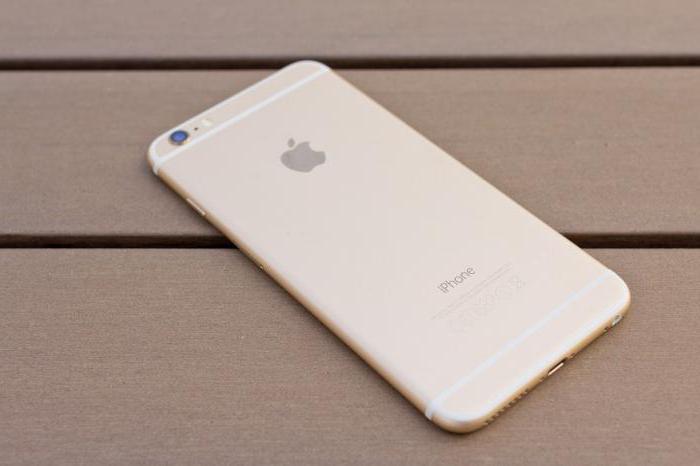
About operating systems Enough has already been said. Another important aspect is the design of the device. Deny importance appearance It’s stupid, but each person has their own definition of beautiful, so there’s no point in generalizing.
And only by taking into account all these factors, you can understand and be inexpensive at the same time. This means you can make an informed choice, and not just point your finger at the first smartphone you come across.
Display Features
A lot depends on this parameter. Screen size affects your experience while using it. So, when determining the range in which you will choose a good inexpensive phone, pay attention to this.
The most common diagonal is four and a half inches. This, one might say, is the golden mean for such devices. On a display of this size, you can quite comfortably watch movies, read books and play games, and at the same time it fits into your pocket. Gadgets with a larger diagonal have a greater range of capabilities, but the trousers will have to be redesigned.
In addition, devices with a diagonal of five inches and above no longer fall under the definition of inexpensive, since budget devices are not made in this size.
In this matter, in addition to size, also look at the resolution. This is a determining factor for image quality. If we take a diagonal of four and a half inches, then a resolution of 1280 x 720 pixels will be quite enough. Less - the quality will be quite low, and if higher, the price of a good inexpensive phone will increase. However, if you find it with a resolution of 1920 x 1080, share it with everyone - people will be very interested.
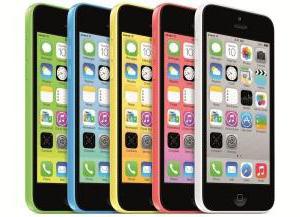
Processor and memory
Good mobile phones are inexpensive because the manufacturer has managed to find a balance between the price of components and their power.
With a processor, you need to pay attention to a few key indicators. First of all, this is the model and generation - you can find them out by copying the name from the description into a search engine. Then just read what you found in the first few links. Find out if this thing is worth taking. Second parameter - clock frequency. You should know one thing: the larger it is, the better the result.
Memory can be RAM or built-in - both are always present. The RAM determines the number of possible operations that are carried out simultaneously. A good inexpensive phone usually has a one GB option, although you can find 512 MB and 2 GB. The last option is, of course, preferable. But one “gig” is enough for your daily work. If the memory is smaller, then it is no longer possible to say what the performance will be.
The built-in memory determines how much information can be recorded without external devices. In general, this indicator is not critical, the main thing is that the phone has a slot for a memory card.
Battery
What phones are good and inexpensive, touchscreen at the same time as these parameters? Operating time plays a big role here. The power may not be particularly large, the main thing is that it is enough for everyday tasks. But charging the device every couple of hours is not very pleasant. And this has nothing to do with its price.
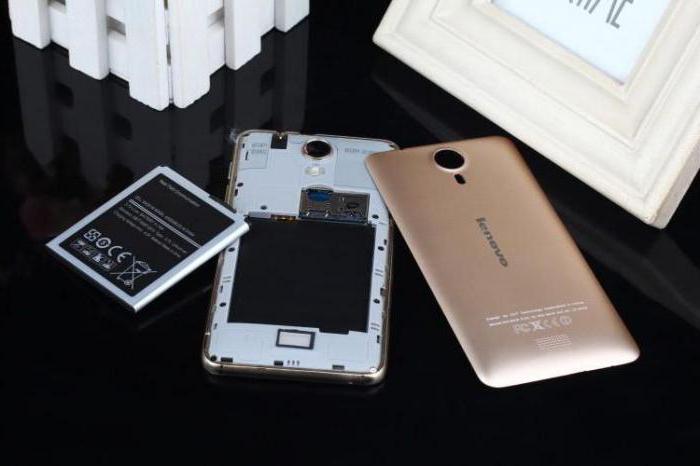
So choose the largest number you can find. For budget options A typical figure is two thousand mAh, plus or minus two hundred. If you find something larger, and even suitable according to other parameters, take it without hesitation.
Camera
If you can’t imagine life without photos, then pay attention to the camera built into your phone. In fact, in modern mobile gadgets there are usually even two of them - on the back panel and the front panel, intended for selfies. The first is better than the second by definition.
It is worth paying attention to such parameters as the number of pixels, flash or lack thereof, as well as additional features like autofocus, face detection, etc.
For most inexpensive models The typical indicator is from 8 to 13 megapixels. This is quite enough for high-quality amateur photography in a friendly environment (without rain, fog and in normal lighting).

How do you know what you need?
In fact, the determining factor when buying a smartphone is its requirements. That is, not to him technical specifications, namely what you are going to do with it. This side of the issue is not always thought about, but it is very important.
Ask yourself what exactly do you need from a new phone? Then you can set the necessary search parameters in the online store. By the way, the requirements can be very different, right down to “making an impression with your coolness” - this option, of course, is not in the menu, but you can rely on the brand, design and display size.
In general, we can’t say that this one is the best and most inexpensive phone. Don't pay attention to others. That's not how things work here. A low price means a reduction in performance for one of the features mentioned earlier. So you still have to choose between speed, large screen, high-quality picture, good camera, expensive glass, brand name, etc. The list is quite long. And you will have to work with this.
So, we found out how to choose an inexpensive but good phone.
There are currently 2 main types of touch screens used in phones and communicators: resistive and projected capacitive, and the latter have become much more common over the past 2 years. In both cases, to recognize touches, a special electrically conductive material is used, which closes at the moment the finger touches the substrate that protects this material.However, in projective-capacitive screens, the role of the conducting layer is performed by transparent electrons protected by glass. In this case, it acts as a dielectric, thanks to which this type of touch displays clearly distinguishes the places of contact of fingers with the screen. If the buyer is faced with the task of saving on quality touch screen, then the resistive type is suitable for it. It is used in the production of budget models of communicators such as ZTE, Huawei and Highscreen.
First touch smartphone was announced by Nokia back in 2001, but the company did not release it to the market due to the desire to stir up interest in its revolutionary new product. It was never released.
Ease of use
To display images on the screen display, use Various types matrices At the moment, there are phones on the market with two types of matrices: TFT and IPS. The first type is more faded, it fades in the sun, but its resistance to wear is much higher than that of IPS. In the case of this type, there is a bright, rich display that does not fade in the sun and has richer color rendition. But smartphones and phones with this type of screen are much more expensive than gadgets with a TFT matrix.Technology IPS matrices does not stand still, the price of touchscreen phones using such screens has dropped significantly recently. Therefore, it will not be difficult for the consumer to choose a phone with a clearer and richer image. Lenovo communicators offer the optimal price-quality ratio for this parameter.
Touch Screen Options
To make touch displays more convenient and practical to use, additional options have been developed for them. The first of them is Multi-Touch technology. With its help, any of the above types of screens can accept up to five simultaneous clicks, which will be perceived by the device. The second high-quality addition to the touch display is the presence of protective Gorilla Glass, which will protect it from shocks, scratches, moisture, etc.In addition to the described capabilities, a light sensor can be attached to the touch screen, which can reduce or increase the brightness according to automatic mode. This is extremely convenient for saving the device's battery. The presence of all these technical solutions will make the phone expensive, but easy to use. There are many models of smartphones on the market in one configuration or another that can satisfy any user.
When choosing between a touch phone and a communicator, you need to understand that the communicator is more adaptable to changing its functions for a specific user.
Choosing a brand of touch screen phone
Many manufacturers are now producing phones with touch screens. Leading positions are occupied by brands such as Samsung, Apple, HTC, Huawei, Sony. All smartphones and phones of these brands are different good quality and the use of advanced technical solutions in their production. An expensive touchscreen phone will please your eyes with its quality and display. Therefore, you should not skimp on the quality of the screen, since the health of the user’s eyes depends on it.Screens modern devices are capable of not only deducing useful information and images, but also allow you to interact with the device itself using sensors. Initially, touch screens were used only in some models of handheld computers, but today touch screens are widely used in various mobile devices, video and photo cameras, players, information kiosks and other devices. It is worth noting that such devices use one of the types of touch screens. Today, several types of touch panels have been developed and are widely used, each of which has its own advantages and disadvantages.
At the moment, there are four main types of touch screens: infrared, capacitive, resistive, and surfactant touch screens. Capacitive and resistive touch screens are the most widely used in mobile devices. Without going into details, we can say that their main difference is that capacitive screens recognize touch, while resistive screens recognize pressure.
Resistive touch screens
Resistive touch screens are widely used in mobile devices. This is due to the low manufacturing cost and simplicity of the technology. The resistive touch screen is LCD display, on which two transparent plates are installed on top, between which there is a dielectric layer. The top plate that the user presses on is flexible, while the bottom plate is rigidly attached to the screen. Conductors are applied to the surfaces of the plates facing each other.
The voltage is sequentially supplied by the microcontroller to the electrodes of the lower and upper plates. At the moment when the user presses the screen, the upper plate bends and its conductive layer touches the lower one, and the resistance of the entire system changes. The microcontroller records this change and determines the coordinates of the pressing point.
The advantages of resistive screens include low production costs and good sensitivity. In addition, the resistive screen can be pressed either with a finger or with any other object.
Disadvantages include poor light transmission. This is compensated by brighter backlighting. Resistive touchscreens do not support multiple clicks (multi-touch) and cannot measure pressure. The disadvantages also include fairly rapid mechanical wear, however, compared to the period of operation of a mobile phone, this disadvantage turns out to be not so important, since the phone in most cases fails earlier than its touch screen.
Resistive touch screens are used in PDAs, mobile phones, communicators, smartphones, POS terminals, medical equipment.
SAW touch screens (based on surface acoustic waves)
The operating principle of the surfactant screen is as follows. In the corners of the screen there are piezoelectric elements that convert the supplied electrical signals into ultrasonic waves and directing them along the surface of the screen. On the back of the screen there are reflectors that distribute these waves throughout the screen. On the opposite sides of the screen from the reflectors there are sensors that focus ultrasonic waves and transmit them to the transducer. The transducers, in turn, convert sound waves into electrical signals and feed them to the microcontroller. So for a microcontroller, the screen is a digital matrix, each cell of which corresponds to a specific point on the screen.
At the moment when the user touches the screen with his finger, ultrasonic waves are absorbed at the point of contact, and, as a result, the overall pattern of wave distribution changes. At the point of contact, ultrasonic waves are absorbed, as a result, a weak signal corresponding to a logical zero appears at the output of the transducer. In this way, the coordinates of the tangent point are calculated.
The advantages of SAW touch screens include durability (up to 60 million touches), excellent transparency, since the screen has no conductive surfaces. In addition, surfactant touch screens can determine not only the coordinates of the point of pressing, but also the force of pressing.
Among the disadvantages are low accuracy determination of coordinates, compared to capacitive ones. Also, when exposed to various vibrations and acoustic noise, malfunctions in the operation of the screen are observed. Any dirt on the screen can block its operation.
Surfactant touch screens are used in slot machines, educational institutions, and information kiosks.
Infrared touch screens
The operating principle and design of the touch screen is similar to the surfactant screen. On two adjacent sides of the screen there are LEDs that emit infrared rays. On opposite sides there are phototransistors that receive these rays. Those. the entire screen is, as it were, covered with a grid of intersecting perpendicular rays. The moment the user touches the screen, the rays overlap and do not reach the phototransistors. The microcontroller reads this information and determines the coordinates of the touch point.
Infrared touch screens are used in vending machines, information kiosks, medical equipment and other devices.
Among the advantages of infrared screens are the simplicity of the device, maintainability, durability, and strength.
Capacitive touch screens
Capacitive touch screens are divided into two types: projected capacitive and surface capacitive. Surface capacitive screens consist of glass, on the surface of which a transparent thin conductive coating is applied, protected on top by a film. Along the edges of the glass plate are printed electrodes, through which a low-voltage alternating voltage is applied to the conductive coating by a microcontroller.
The moment the user touches the screen, a current pulse is generated at the point of contact. Moreover, its value is proportional to the distances from the point of contact to the corners of the screen. The microcontroller reads this information and calculates the coordinates of the touch point.
The advantages of surface capacitive touch screens include excellent light transmission, long touch life and short response time.
Disadvantages include the requirement for external temperature; the electrodes located on the sides of the plate are in most cases not suitable for mobile devices. In addition, surface-resistive screens do not support multiple touches and cannot determine the pressing force. You can only touch such screens with a special stylus or your fingers.
Surface capacitive touch screens are used in information kiosks, some ATMs and secure areas.
The design of projected capacitive touch screens includes glass, on which horizontal leading and vertical defining lines of conductive material are applied, which are separated by a layer of dielectric.
The operating principle of a projected capacitive touch screen is as follows. A voltage is applied to the electrodes located in the conductive layer by a microcontroller and the amplitude of the current pulses is measured. When you touch the screen, the capacitance of the electrodes at the point of contact changes. In this case, the microcontroller can determine the location of the touch (the intersection of the electrodes with a large capacitance).
Among the advantages of projected capacitive touch screens are the fast response speed to touch, multi-touch support, the ability to determine the force of pressing, and a more accurate determination of touch coordinates compared to resistive screens. In addition, projection-resistive screens have great reliability and service life.
Areas of application for projected capacitive screens: ATMs, payment terminals, laptop touchpads, communicators, iPad, iPhone and other devices.
